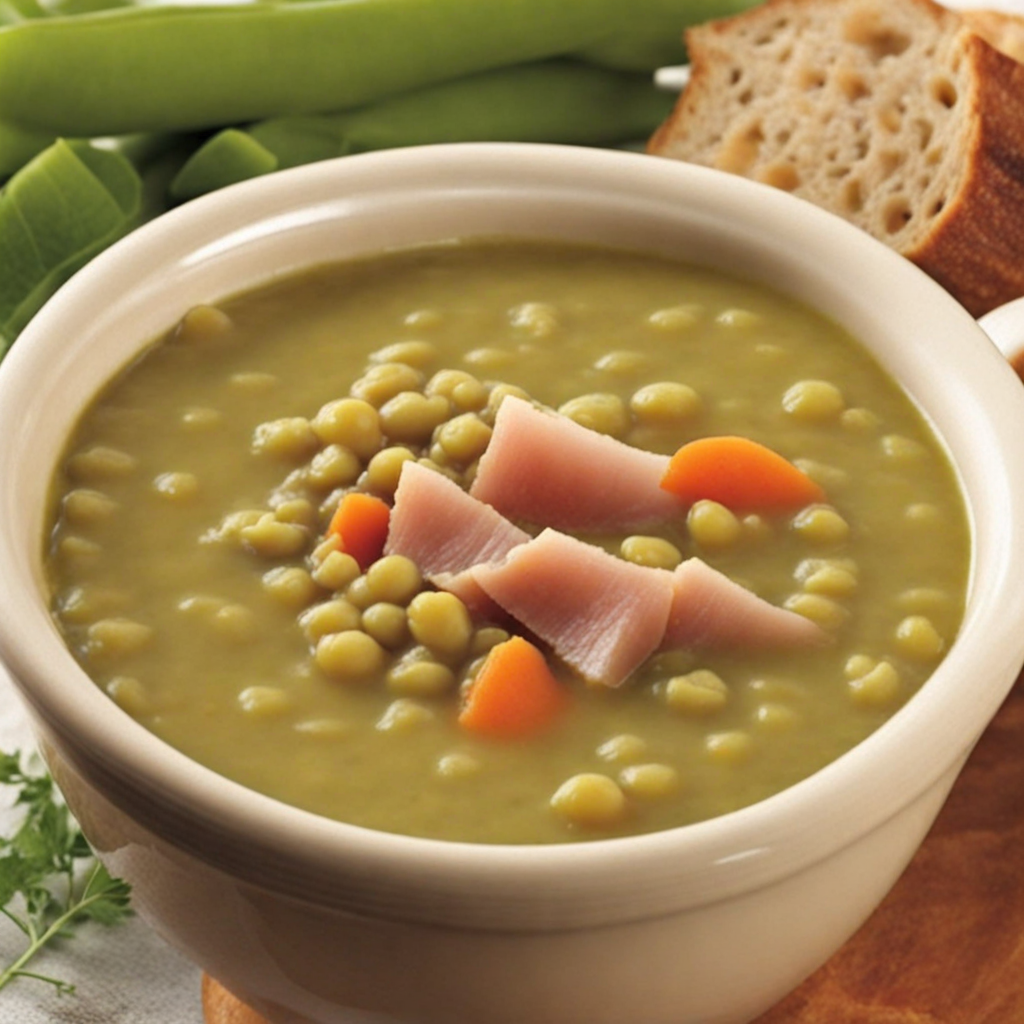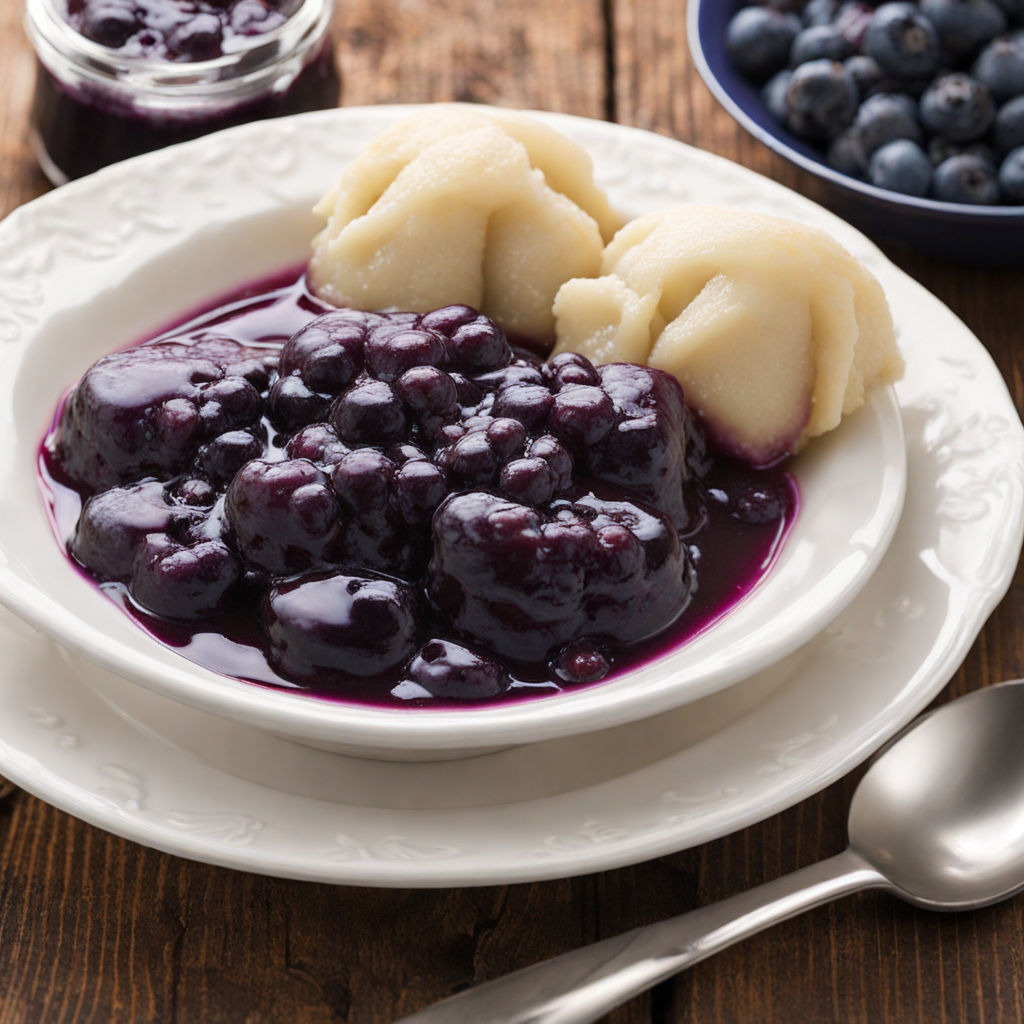Split Pea Soup
Split Pea Soup is a hearty and comforting dish that hails from the rich culinary tradition of Canada. This thick and creamy soup is primarily made from dried split peas, which are cooked until tender and then pureed to create a smooth texture. The natural sweetness of the peas is enhanced by the addition of vegetables such as carrots, celery, and onions, which bring depth and aroma to the dish. Often seasoned with herbs like thyme and bay leaves, the soup offers a fragrant profile that warms the soul with every spoonful. Traditionally, Canadian Split Pea Soup is made with ham or bacon, which adds a savory, smoky flavor that complements the earthiness of the peas. The meat infuses the broth with richness, making it a satisfying meal that can stand on its own. For those seeking a vegetarian option, the soup can easily be adapted by omitting the meat and utilizing vegetable broth while still capturing the essence of the dish. The vibrant green color of the soup makes it visually appealing, and it can be garnished with croutons or fresh herbs for an added touch. This dish is not only delicious but also packed with nutrients, making it a great choice for a wholesome meal. Split peas are an excellent source of protein, fiber, and vitamins, contributing to a balanced diet. Whether served as a starter or a main course, Canadian Split Pea Soup invites you to experience the rustic flavors of the region, providing a taste of comfort that warms both the body and spirit.
How It Became This Dish
Soupe aux Pois Cassés: A Culinary Journey Through Canadian History #### Origins Soupe aux pois cassés, or split pea soup, is a dish that resonates deeply within the culinary traditions of Canada, particularly among the Francophone communities of Quebec. Its history can be traced back to the indigenous peoples of North America, who cultivated various legumes, including peas, long before European settlers arrived. The split pea, a staple in many cultures, became especially prominent in French cuisine and was integrated into the culinary practices of New France. When French settlers established themselves in Canada in the early 17th century, they brought with them a rich culinary heritage. The use of legumes, such as peas, lentils, and beans, was common in France, where peasants relied on these ingredients for sustenance. The harsh Canadian winters necessitated hearty, nutritious meals, and split peas provided an excellent source of protein that could be stored for long periods. This adaptability to local conditions allowed Soupe aux Pois Cassés to flourish as a staple in the Quebecois diet. The earliest versions of this soup were simple, focusing on the split peas themselves, often seasoned with herbs and perhaps a little salt pork or bacon for flavor. This reflects a broader trend in early Canadian cuisine, which relied heavily on local ingredients and the preservation techniques necessary for surviving harsh winters. #### Cultural Significance Soupe aux Pois Cassés is more than just a dish; it embodies the spirit of community and tradition in Quebec and Canada at large. The soup is often associated with family gatherings, celebrations, and the warmth of home cooking. In Quebec, it is commonly served during the winter months and at festive occasions, such as the traditional "soupe aux pois" served at the sugar shacks (cabane à sucre) during the maple syrup season. The soup's significance is also tied to its role in the French-Canadian identity. The dish is emblematic of the resilience of Quebecois culture, which has thrived through centuries of colonial challenges and cultural assimilation. The act of sharing a warm bowl of split pea soup is a way of preserving and passing down traditions through generations, connecting families and communities to their heritage. Soupe aux Pois Cassés is also a symbol of the broader Canadian multicultural mosaic. As immigrants from various backgrounds settled in Canada, they brought their culinary traditions with them, enriching the Canadian food landscape. While the soup retains its French roots, it has been adapted over time to incorporate diverse ingredients and methods, reflecting the evolution of Canadian cuisine. #### Development Over Time As time passed, Soupe aux Pois Cassés underwent various transformations, adapting to the changing tastes and preferences of the Canadian population. In the early 20th century, the soup began to gain popularity beyond Quebec. The emergence of canned soups and convenience foods in the mid-20th century introduced split pea soup to a broader audience, making it accessible to those who might not have the time or resources to make it from scratch. The classic recipe typically includes split peas, water or broth, onions, carrots, celery, and a variety of seasonings. The addition of ham hocks, smoked pork, or bacon has become a common practice, enhancing the flavor profile and making the soup even heartier. Additionally, some modern interpretations have introduced a variety of herbs and spices, such as thyme or bay leaves, giving the traditional dish a contemporary twist. In recent years, there has been a resurgence of interest in traditional and homemade foods, leading to a renewed appreciation for Soupe aux Pois Cassés. Many chefs and home cooks are returning to the roots of the recipe, experimenting with different methods of preparation, including slow cooking, pressure cooking, and even vegan versions that substitute meat with smoked paprika or liquid smoke for depth of flavor. The soup's adaptability has also allowed it to fit into the growing movement towards sustainable eating. Split peas are an environmentally friendly ingredient, requiring less water and resources to grow compared to animal proteins. As people become more conscious of their food choices, Soupe aux Pois Cassés stands out as a nourishing, sustainable, and economical option. #### Modern Interpretations In contemporary Canadian cuisine, Soupe aux Pois Cassés has found its place in various culinary contexts. Chefs at high-end restaurants sometimes elevate the dish, using artisanal ingredients and innovative techniques to create refined versions that pay homage to the original while appealing to modern palates. These interpretations might include gourmet toppings, such as truffle oil, crispy vegetables, or house-made croutons, which add a new dimension to the traditional recipe. Moreover, the soup has found its way onto the menus of food trucks and casual dining establishments, embracing the growing trend of comfort food with a twist. This has helped to keep the dish alive in the collective consciousness, ensuring that it remains relevant in contemporary Canadian cuisine. Cultural festivals and events celebrating Quebecois heritage often feature Soupe aux Pois Cassés as a highlight, allowing both locals and tourists to experience this beloved dish. The soup is often served alongside traditional bread, such as homemade baguettes or cornbread, further enhancing its role as a communal dish. #### Conclusion Soupe aux Pois Cassés is a rich tapestry woven into the fabric of Canadian culinary history. From its humble beginnings as a sustenance-driven meal for early settlers and indigenous peoples to its status as a beloved dish that embodies community and culture, the soup has evolved significantly over time. It serves as a testament to the resilience of traditions and the adaptability of food in the face of changing societal landscapes. As Canadians continue to embrace their diverse culinary heritage, Soupe aux Pois Cassés remains a symbol of warmth, nourishment, and connection to the past, ensuring its place in the hearts and kitchens of many for generations to come. Whether enjoyed in a cozy home during winter or savored at a vibrant festival, this delicious soup is a celebration of both history and culture, inviting all to partake in its timeless goodness.
You may like
Discover local flavors from Canada







